- Clinical Technology
- Adult Immunization
- Hepatology
- Pediatric Immunization
- Screening
- Psychiatry
- Allergy
- Women's Health
- Cardiology
- Pediatrics
- Dermatology
- Endocrinology
- Pain Management
- Gastroenterology
- Infectious Disease
- Obesity Medicine
- Rheumatology
- Nephrology
- Neurology
- Pulmonology
Stasis Dermatitis With Id Reaction and Granuloma Annulare in a 60-Year-Old Woman
For several months, a 68-year-old man has had a highly pruritic rash on his lower legs. A similar rash recently arose on his trunk and arms. Treatment with a corticosteroid cream has been ineffective. The patient has diet-controlled diabetes and hypertension that is well controlled by medication.
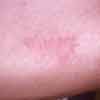

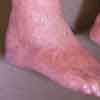
Case 1:
For several months, a 68-year-old man has had a highly pruritic rash on his lower legs. A similar rash recently arose on his trunk and arms. Treatment with a corticosteroid cream has been ineffective. The patient has diet-controlled diabetes and hypertension that is well controlled by medication.
What type of outbreak is this?
A. Psoriasis. B. Stasis dermatitis with id reaction. C. Contact dermatitis. D. Adverse drug reaction. E. Asteatotic eczema.
(Answer on next page.)



Case 1: This patient has stasis dermatitis with id reaction, B. After he was treated for 3 weeks with a diuretic and support hose, the rash started to resolve. Id reactions are a poorly understood phenomenon most commonly associated with tinea pedis, but they have also been reported in conjunction with other conditions.
The distribution of the patient's rash excludes psoriasis. Contact dermatitis is possible, although the distribution does not suggest any particular culprit. Patch testing would be a reasonable option. An adverse drug reaction typically presents as a widespread erythematous maculopapular eruption. Asteatotic eczema usually occurs above the legs and responds to moisturizers and topical corticosteroids.
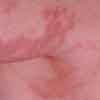
Case 2:
For 2 to 3 months, a 60-year-old woman has been bothered by a slightly pruritic rash that has been slowly progressing, primarily on the trunk. She is otherwise healthy and takes no medications.
What does this look like to you?
A. Sarcoidosis.
B. Psoriasis.
C. Granuloma annulare.
D. Lichen planus.
E. Tinea corporis.
Bonus question: Which laboratory test would be a reasonable option in patients with this condition?
(Answer on next page.)

Case 2: A biopsy confirmed the diagnosis of granuloma annulare, C. The generalized form seen here is more common than the localized formin older women. Sarcoidosis should always be included in the differential of a rash that resembles this one. Psoriasis, lichen planus, and tinea corporis are scalier and more pruritic than this patient's rash.
Answer to bonus question: A serum glucose test is a reasonable diagnostic option. Generalized granuloma annulare has been reported in patients with diabetes.1
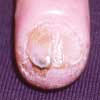

Case 3:
For several months, a 45-year-old woman has been bothered by changes to the lateral and proximal fingernail folds. A biopsy performed by another physician suggested verruca vulgaris. Treatment with cryotherapy and imiquimod brought no improvement.
What action would you take?
A. Refer the patient for laser therapy.
B. Refer the patient for intralesional immunotherapy.
C. Consider alternative diagnoses.
D. Perform another biopsy.
(Answer on next page.)


Case 3: A review of the histology report revealed that the definitive features of verruca vulgaris (such as coarse keratohyalin granules, perinuclear vacuolization or koilocytotic cells in the granular layer, and hyperkeratosis with focal parakeratosis) were absent, and that the nail changes might be attributable to trauma. These findings strongly suggested factitious injury. On further questioning, the patient reported significant stress in her life, which was undoubtedly the precipitating factor.
It is always reasonable to consider alternative diagnoses, C, or a repeated biopsy, D, when a patient fails to respond to treatment for the presumed diagnosis.
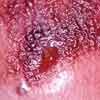
Case 4:
This acute pruritic eruption developed on the back of a 49-year-old woman's leg after she had been doing yard work. She promptly sought medical attention, and ceftriaxone was prescribed for a presumed infection. However, the outbreak has remained unchanged for 2 days. The patient has no fever, chills, or red streaks, and she is otherwise healthy.
What is the most appropriate course of action?
A. Add oral doxycycline or trimethoprim/sulfamethoxazole to cover for methicillin-resistant Staphylococcus aureus.B. Administer IM triamcinolone, 60 mg.
C. Add oral fluconazole for 10 days for a presumed fungal infection.
D. Add dapsone for a presumed brown recluse spider bite.
E. All the above.
(Answer on next page.)

Case 4: A bacterial culture grew no organisms, and biopsy results were consistent with an insect bite reaction. The exuberant outbreak indicated infection, although the pruritus might suggest an allergic reaction. The patient's condition responded to IM triamcinolone, B, and she was instructed to use insect repellants.
A fungal infection would not produce such a dramatic response in such a short period, and brown recluse spider bites are typically painful and more necrotic.
References:
REFERENCE:1. Guardiano RA, Lee W, Norwood C, Darling T. Generalized granuloma annulare in a patient with adult onset diabetes mellitus. J Drugs Dermatol. 2003;2:666-668.
